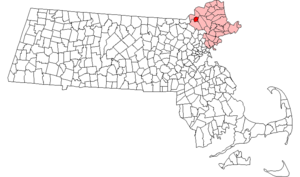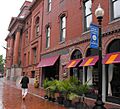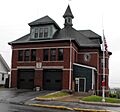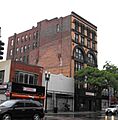National Register of Historic Places listings in Lawrence, Massachusetts facts for kids
Have you ever wondered about the old buildings and places in your town? Some of them are so special that they are put on a very important list called the National Register of Historic Places. This list helps protect buildings, neighborhoods, and other spots that have a cool history. It's like giving them a special badge of honor!
Lawrence, Massachusetts, is a city with a really interesting past, especially known for its big textile mills. Because of this, many places in Lawrence are on this important list. In fact, out of 461 historic places in Essex County, Lawrence is home to 24 of them! These places tell stories about how Lawrence grew, how people lived and worked, and what was important to the community long ago.
Contents
Historic Places in Lawrence
Lawrence has many different kinds of places on the National Register. Some are old factory buildings, some are homes, and others are important public spaces. Each one helps us understand the city's journey through time.
Mills and Factories
Lawrence was famous for its textile mills, which were huge factories that made cloth. Many of these old mill buildings and the areas around them are now protected.
American Woolen Company Buildings
The American Woolen Company was a very large textile company. They built special houses for their workers, known as the American Woolen Company Townhouses. These homes, located on Wood Way, Washington Way, and Prospect Way, show us how mill workers lived. There's also the American Woolen Mill Housing District on Market Street, which includes more homes built for these workers.
Arlington Mills Historic District
The Arlington Mills Historic District was another huge mill complex. It stretches along Broadway and includes many buildings that were part of this massive factory. This area even extends into the nearby town of Methuen!
Essex Company Machine Shop
The Essex Company Machine Shop on Union Street was a vital place. This is where machines for the mills were built and repaired. It was a central spot for keeping the huge textile industry running smoothly.
North Canal and Great Stone Dam
The North Canal runs parallel to Canal Street. This canal was dug to bring water from the Merrimack River to power the many mills in Lawrence. It was a huge engineering project! The water for the canal came from the Great Stone Dam on the Merrimack River. This massive dam was built to control the river's flow and provide power for the entire city's industries. It's an amazing example of old engineering. The area around the canal is also part of the North Canal Historic District, which includes many of the old mill buildings.
Wood Worsted Mill
The Wood Worsted Mill on South Union Street was one of the largest textile mills in the world when it was built. It's a huge building that shows just how big the textile industry was in Lawrence.
Homes and Neighborhoods
Beyond the mills, many neighborhoods and individual homes are also historic. They show us how people lived and the different styles of buildings from the past.
Arlington-Basswood Historic District
The Arlington-Basswood Historic District is a neighborhood with many historic homes. It's roughly bounded by Lawrence, Alder, Arlington, and Juniper Streets. Walking through this area is like taking a step back in time.
Jackson Terrace Historic District
The Jackson Terrace Historic District includes homes on Jackson Street, Jackson Court, Jackson Terrace, and Newberry Street. These homes show the different types of houses built for people working in Lawrence.
Sacred Heart Parish Complex
The Sacred Heart Parish Complex on South Broadway is a group of buildings related to a church. These complexes often include the church, a rectory (where the priest lives), and sometimes a school, showing the importance of community and faith.
Public Buildings and Spaces
Lawrence also has historic public buildings and spaces that served the community.
Bellevue Cemetery
Bellevue Cemetery on May Street is a historic cemetery. Cemeteries can be important historic places because they show us how people honored their dead and often have beautiful old monuments and landscaping. This cemetery also extends into Methuen.
Blakeley Building
The Blakeley Building on Essex Street is an example of a historic commercial building. These buildings often housed shops or offices and were important parts of the city's downtown area.
Downtown Lawrence Historic District
The Downtown Lawrence Historic District covers a large part of the city center. It includes many of the old commercial buildings, public buildings, and streets that made up the heart of Lawrence.
Engine House No. 6
Engine House No. 6 on Howard Street was an old fire station. These buildings are important because they show how cities provided essential services like fire protection long ago.
Old Public Library
The Old Public Library on Hampshire Street was once the main library for the city. Libraries are key community buildings, and this old one tells a story about education and public access to books in the past.
John R. Rollins School
The John R. Rollins School on Howard Street and the Daniel Saunders School on South Broadway are examples of historic school buildings. They remind us of how important education has always been in Lawrence.
High Service Water Tower and Reservoir
The High Service Water Tower and Reservoir is located off Route 110. This impressive structure was part of the city's water system, providing clean water to homes and businesses. It's a great example of public works from the past.
Images for kids


























